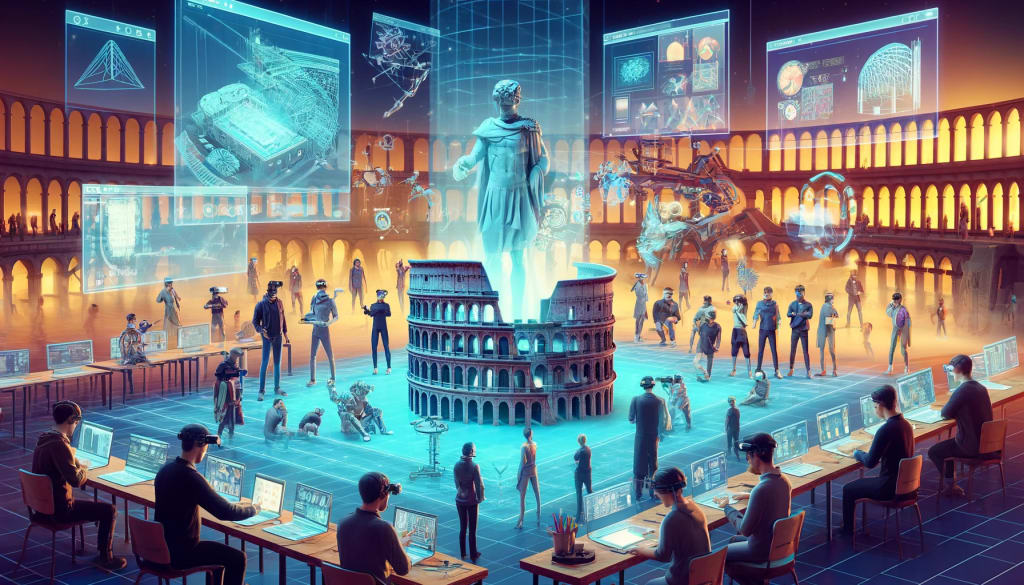Metaverses: a game or a second life?
Exploring the Boundless Potential of Metaverses in 3D Visualization and Virtual Engagement

After December 2019, when the first case of coronavirus was officially confirmed, in addition to the obvious terrifying consequences, the pandemic gave rise to interesting words that succinctly reflected the deep meaning of what was happening.
For example, many companies were forced to experience the remote work format, which led to the concept of hotelling. Its essence is the reservation of office space using an application. Dry small talk became more common, which colleagues missed in the distributed team conditions. They wanted more socialization.
Time for completing work tasks was "tracked" while sitting at home. Zoom or the more archaic Skype, of course, addressed many issues with the looming threat, but the boundaries of "coffee break" became very blurred, as did the actual working hours.
However, some were not greatly frightened by the new circumstances. They quickly adapted to the good. Any meet-up and a muted microphone turned out to be seconds won to do household chores or simply get more sleep. Productivity did not suffer, unless it was necessary to search for some plankton outside the access zone, causing deadlines to be missed. In that case, it was necessary to optimize efforts and somehow save the project from "failure." At the same time, live communication with colleagues was lost, as they appeared on the screen like a tapestry of sometimes "frozen" faces. The problem of working remotely, perhaps, became much scarier than the coronavirus. The first signs of "melancholy" and a sense of loss of personification appeared. The level of presence in one's own life dropped like Bitcoin.
But they found a vaccine - life in the matrix. The pill was called metaverses. When Morpheus gave people a choice, those who considered metaverses a soap bubble chose the red pill. The blue one was taken by technological apologists, extremists, and just enthusiasts. The last group decided to transfer to the virtual world and embody all their dreams in the simulation.
The immersive ticket to Rome
To bring their own ideas to life, one must know how to implement them. Usually, it's not easy to handle such a task alone. Metaverse design agencies work on developing projects in metaverses, setting specific goals for themselves.
Let's say within the realm of fantasy, they want to build a replica of the Colosseum, organize one of the most anticipated events of the year in the world of combat sports, and sell as many tickets as possible. Considering the scale of the event - a fight between Mark Zuckerberg and Elon Musk - the tickets should sell like hotcakes. The demand for the duel at the 300th anniversary event of UFC in the metaverse may also increase because in real life, a showdown between the two entrepreneurs seems unlikely, as someone is constantly looking for reasons to postpone the fight. This raises doubts about the seriousness of the intentions of the two billionaires.
In the metaverse, on the contrary, there will be no place for these feelings, because the development team will ensure the accessibility of the virtual world, immersing the viewer in a "natural" atmosphere. In this "universe," even the emotions during the stare-down between the fighters will not differ from "real" ones.
One man, no man
How is it possible to create such a realistic experience? It all starts small, when an empath designer comes to their colleagues with a million written scenarios. To put them together correctly, a storyboard tool can be used, which is often found in the film industry. Any narrative expressed graphically brings the idea to life and provides answers to questions about the "viewer's" needs. "Storytelling" can tell how the user will book a plane ticket to Rome and what obstacles they will face along the way. This will reveal flaws in the work and also push towards writing "incorrect" scenarios. In the context of building the Colosseum in the metaverse, the designer can anticipate specific actions in case of a lack of seating, for example. This way, the team will prevent a disaster - potential dissatisfaction of tournament visitors - and won't rack their brains over its solution when it's too late. In other words, it will predict any risks.
Once the team has settled on the concept, studied various scenarios, chosen a visual style, and finally found the right solution among the chaos of sketches, mood boards, and references, they begin to build the virtual world, which includes three-dimensional space as the building of the Colosseum, octagon, and "stands." This is usually done by 3D artists who have skills in 3D programs such as 3D's Max, Blender, Cinema 4D, Maya, and others.
However, creating realistic objects or any attribute around a person is only half the battle. It is important to understand how and by what means they will interact with each other. This is again solved by a large team, which may include a project manager, producers, developers, animators, illustrators, marketers, game designers, photographers, and videographers.
After roles are assigned, the "construction" of the interactive elements begins using specialized software. For example, the Interaction SDK tool created by Meta offers great possibilities (distance calculator, gesture detection) for interacting with content using hands and controllers: moving, throwing, dragging something - and many more actions. Within the team's "fantasy," the viewer can ask for Dana White's autograph, taking a marker or pen with them.
Considering the rapid evolution and the growing capabilities of metaverses, it's essential to look at the broader impact these technologies might have. Matthew Ball, a technologist and author, emphasizes the transformative potential of graphical interfaces and 3D environments:
"I believe absolutely that the advent of graphics-based computing and 3D environments is going to change many of the technologies, standards, conventions, and monetization models,' expecting these advances to profoundly alter sectors previously untouched by mobile and internet technologies."
The final stage of creating a project in the "fighting" metaverse will be testing. Through this, the team will identify bugs in the virtual world and pinpoint areas that require improvement.
In summary, a large team works on the three-dimensional spaces and content for virtual reality in the metaverse. For technical implementation, it is important to know programs and engines, and management in the created world is done using VR controllers and cameras that track a person's movements in real time.
As we explore the practical applications of metaverses, it's crucial to consider the perspectives of industry leaders on this evolution.
"In my company, we strive not only to follow trends but also to set them. The development of metaverses opens new horizons for 3D visualization, and we have already made our mark in this direction by successfully completing projects for virtual offices for a well-known IT company. Considering forecasts that the metaverse market will reach $800 billion by 2025, this direction is one of our priorities for the coming years"
— says Alexander Kasperovich, CEO of Studio57.
Organizational aspects
Metaverses indeed offer no less opportunities than real life. Getting positive and vivid emotions here is also not a problem. Want to visit Salvador Dali's exhibition or present your own art collection? You can. Want to hold a business meeting in a conference room in Stockholm? It's possible. But only on one condition - you need to know the rules and principles of organizing events in Web3:
The sea should not be agitated
Desynchronization of a person's movements in reality with the visible movements in the virtual world can cause at least motion sickness. At most, it can lead to more serious health problems. For these reasons, it is important for the designer to correctly design the virtual space.
Megalodon in Metaverses
From a content perspective, the formats in the metaverse remain familiar to earthlings: read science fiction, listen to Britney Spears, watch Jason Statham once again save the world - all is fair game. The question is how these formats will be implemented technically. For example, in the open-source version, the Spatial platform specifies the recommended format for a 3D model - glb, glTF less than 100 MB, or for video content - mp4, mov less than 50 MB, gif less than 200 MB.
Ways of consuming "content" can be experimented with at least until 2030, but in any case, they must meet the metaverse's requirements.
Decentralized payment systems
Some virtual worlds are built on the principle of decentralization, allowing payment for goods with cryptocurrency (which is more convenient than using real money). For example, in Decentraland, Spatial, and Sanbox platforms, there is their own internal currency MANA, SPAT, and SAND respectively.
Identity without end
There are non-fungible tokens, thanks to which the user will always keep their identity under any circumstances and will be able to jump across universes. You can move from Fortnite to The Sandbox, and even directly from the office, you will be transported closer to the ocean.
About the Creator
Enjoyed the story? Support the Creator.
Subscribe for free to receive all their stories in your feed. You could also pledge your support or give them a one-off tip, letting them know you appreciate their work.






Comments
There are no comments for this story
Be the first to respond and start the conversation.